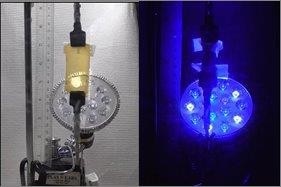Apr 3 2019
Similar to how controlled-release medications gradually dispense their carrier once they experience a pH variation in the body, implanted “artificial muscles” could one day contract and relax in response to light irradiating the skin. In pilot projects, researchers have created a new material that flexes and relaxes to lift a weight simply by irradiating a light on it.
 A polymer (left; beige material) contracts in blue light (right). (Image credit: Jonathan Barnes)
A polymer (left; beige material) contracts in blue light (right). (Image credit: Jonathan Barnes)
The scientists will demonstrate their outcomes at the American Chemical Society (ACS) Spring 2019 National Meeting & Exposition on April 2nd, 2019. ACS, the largest scientific society in the world, is conducting the meeting until Thursday. It presents almost 13,000 presentations on a broad spectrum of science topics.
We have developed a new polymer that has a novel mechanism for actuating materials—making materials shrink, expand or hold a ‘memory’ of a particular shape—all with a simple stimulus.
Jonathan Barnes, PhD and Assistant Professor, Department of Chemistry, Washington University in St. Louis.
Until now, stimuli-responsive materials have been employed in several different industries. For instance, some materials change color and are used as windshield coatings to immediately shield drivers from the glaring sun. Other materials can be developed into vessels that respond to variations in nutrient concentrations and also feed agricultural crops as required. There are even more applications in the biomedical field.
Barnes and his group at Washington University in St. Louis (WUSTL) are testing their new polymer through its stages to find out what it is specifically suited for. However, the key objective has been to check whether the material can perform tasks, an aspect that could allow the development of an artificial muscle.
At the time of graduate schooling, Barnes studied a group of molecules, called viologens, which change color with the removal and addition of electrons. Barnes believed that if these molecules were connected together, they would fold like an accordion since areas that accept a single electron identify each other. He also speculated whether the action of the folding molecules could make a 3D network move and whether it was possible to make the process reversible.
The group under Barnes at WUSTL produced polymer chains with viologens in their backbones in order to tackle these problems. When illuminated with a blue LED light, the molecules folded into pleats by means of well-established photoredox catalysts that can shift electrons to the viologens. The scientists subsequently integrated the polymers into a flexible, water-soluble 3D hydrogel. When the researchers illuminated light on the gel, the accordion effect that took place within the molecule pulled the gel in on itself, making the material to shrink to one-tenth of its original size. Upon switching off the light, the material expanded. Along with the structural change in the polymer-embedded hydrogel, there was also a change in color.
“The beauty of our system is that we can take a little bit of our polymer, called a polyviologen, and put it in any type of 3D network, turning it into a stimuli-responsive material,” Barnes stated. In order to receive a response, less than 1% of the weight of the hydrogel must contain polyviologen. Therefore, the polymer does not cause a considerable impact on the other properties of the material in which it is contained.
To determine if the material could carry out the task, the researchers fixed the gel to a strip of electrical tape with a piece of wire at the end. Then, they hung a small weight from the wire and suspended the hydrogel opposite to a blue light. The gel lifted the weight—which was around 30 times the size of the embedded polyviologen—and after five hours, it expanded several centimeters.
The team has now made other modifications, such as making the gels more elastic and stronger and making them move more rapidly. Furthermore, the scientists have created polymers that respond to several stimuli promptly. They even developed gels that respond to light at various wavelengths. Materials that react to near-infrared or red light—which can pass through human tissue—could be employed in biomedical applications, for example, drug-delivery devices or, ultimately, as artificial muscles.
Barnes reported that his team has only started to test the limits of these novel materials. At present, the group is examining the self-healing traits of polyviologen-embedded hydrogels, and is studying the possibility of 3D printing the polymers into various kinds of materials.
The scientists acknowledged support and funding from the David and Lucille Packard Foundation Fellowship in Science and Engineering and Washington University in St. Louis.
Artificial Muscle - Headline Science
(Video credit: ACS)